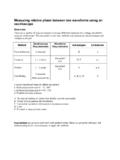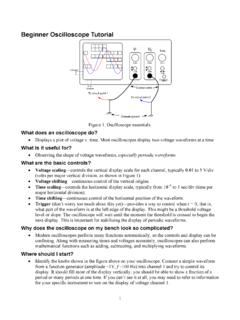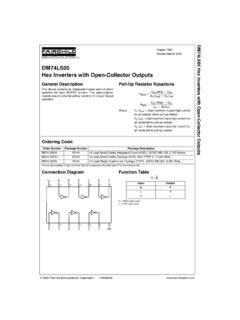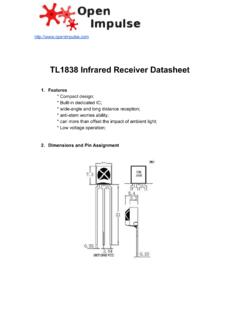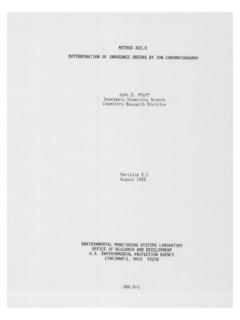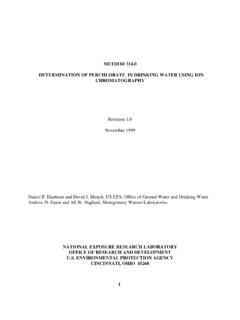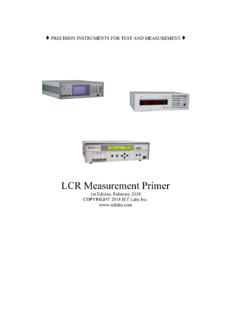Transcription of Keysight U1731C/U1732C/ U1733C Handheld LCR Meter
1 Keysight U1731C/U1732C/ U1733C Handheld LCR MeterUser s GuideU1731C/ u1732c / U1733C User s GuideIIIU1731C/ u1732c / U1733C User s GuideNotices Keysight Technologies 2011 2014No part of this manual may be reproduced in any form or by any means (including elec-tronic storage and retrieval or translation into a foreign language) without prior agree-ment and written consent from Keysight Technologies as governed by United States and international copyright Part NumberU1731-90077 EditionEdition 8, August 2014 Keysight Technologies 1400 Fountaingrove Parkway Santa Rosa, CA 95403 WarrantyThe material contained in this document is provided as is, and is subject to change, without notice, in future editions. Further, to the maximum extent permitted by the applicable law, Keysight disclaims all warranties, either express or implied, with regard to this manual and any information contained herein, including but not limited to the implied warranties of merchantabil-ity and fitness for a particular purpose.
2 Keysight shall not be liable for errors or for incidental or consequential damages in connection with the furnishing, use, or performance of this document or of any information contained herein. Should Key-sight and the user have a separate written agreement with warranty terms covering the material in this document that conflict with these terms, the warranty terms in the separate agreement shall Licenses The hardware and or software described in this document are furnished under a license and may be used or copied only in accor-dance with the terms of such Rights Government Restricted Rights. Soft-ware and technical data rights granted to the federal government include only those rights customarily provided to end user cus-tomers. Keysight provides this customary commercial license in Software and techni-cal data pursuant to FAR (Technical Data) and (Computer Software) and, for the Department of Defense, DFARS (Technical Data - Commercial Items) and DFARS (Rights in Commercial Computer Software or Com-puter Software Documentation).
3 Safety NoticesCAUTIONA CAUTION notice denotes a haz-ard. It calls attention to an operat-ing procedure, practice, or the likes of that, if not correctly performed or adhered to, could result in dam-age to the product or loss of impor-tant data. Do not proceed beyond a CAUTION notice until the indicated conditions are fully understood and WARNING notice denotes a hazard. It calls attention to an operating procedure, practice, or the likes of that, if not correctly performed or adhered to, could result in personal injury or death. Do not proceed beyond a WARN-ING notice until the indicated conditions are fully understood and User s GuideIIIS afety SymbolsThe following symbols on the instrument and in the documentation indicate precautions which must be taken to maintain safe operation of the current (DC)Off (supply)Alternating current (AC)On (supply)Both direct and alternating currentCaution, risk of electric shockThree-phase alternating currentCaution, risk of danger (refer to this manual for specific Warning or Caution information)Earth (ground)
4 TerminalCaution, hot surfaceProtective conductor terminalOut position of a bi-stable push controlFrame or chassis terminalIn position of a bi-stable push controlEquipotentialityEquipment protected throughout bydouble insulation or reinforcedinsulationIVU1731C/ u1732c /U173 3C User s GuideSafety ConsiderationsRead the information below before using this instrument. The following general safety precautions must be observed during all phases of operation, service, and repair of this instrument. Failure to comply with these precautions or with specific warnings elsewhere in this manual violates safety standards for design, manufacture, and intended use of the instrument. Keysight Technologies assumes no liability for the customer s failure to comply with these Disconnect circuit power and discharge all high-voltage capacitors before testing. When measuring in-circuit components, first de-energize the circuits before connecting them to the test leads.
5 This device is for indoor use at altitudes of up to 2000 m. Always use the specified battery type (listed in Product Characteristics" on page 76). The power for the Meter is supplied with a single standard 9 V battery. Observe the correct polarity markings before you insert the battery to ensure proper insertion of the battery in the Meter . Line operation is also possible using a 12 V AC to DC adapter. If a power adapter is selected, please be sure it meets the safety requirements of a relevant IEC User s GuideVWARNING Use this Meter only as specified in this manual; otherwise, the protection provided by the Meter may be impaired. Do not use the Meter if it is damaged. Before you use the Meter , inspect the case. Look for cracks or missing plastic. Pay particular attention to the insulation surrounding the connectors. Inspect the test leads for damaged insulation or exposed metal.
6 Check the test leads for continuity. Replace damaged test leads before you use the Meter . Do not operate the Meter around explosive gas, vapor, or wet environments. Never use the Meter in wet conditions or when there is water on the surface. If the Meter is wet, ensure that the Meter is dried only by trained personnel. When servicing the Meter , use only the specified replacement parts. When using the probes, keep your fingers behind the finger guards on the probes. Connect the common test lead before you connect the live test lead. When you disconnect the leads, disconnect the live test lead first. Remove the test leads from the Meter before you open the battery cover. Do not operate the Meter with the battery cover or portions of the cover removed or loosened. To avoid false readings, which may lead to possible electric shock or personal injury, replace the battery as soon as the low battery indicator appears and User s GuideEnvironmental ConditionsThis instrument is designed for indoor use and in an area with low condensation.
7 The table below shows the general environmental requirements for this conditionsRequirementsOperating temperatureFull accuracy from 10 C to 55 COperating humidityFull accuracy up to 80% RH (relative humidity)Storage temperature 20 C to 70 CStorage humidity0% to 80% RH non-condensingAltitudeUp to 2000 metersPollution degreePollution degree IINOTEThe U1731C/U1732C/ U1733C Handheld LCR Meter complies with the following safety and EMC requirements: IEC61010-1:2001/EN61010-1:2001 (Second Edition) IEC 61326-1:2005/EN 61326-1:2006 Canada: ICES/NMB-001:Issue 4, June 2006 Australia/New Zealand: AS/NZS CISPR11:2004U1731C/ u1732c / U1733C User s GuideVIIR egulatory MarkingsThe CE mark is a registered trademarkof the European Community. This CEmark shows that the product complieswith all the relevant European C-tick mark is a registered trademark of the Spectrum Management Agency of Australia.
8 This signifies compliance withthe Australia EMC Frameworkregulations under the terms of the Radio Communication Act of indicates that this ISM device complies with the Canadian appareil ISM est confomre a la norme NMB-001 du instrument complies with the WEEE Directive (2002/96/EC) marking requirement. This affixed product label indicates that you must not discard this electrical or electronic product in domestic household symbol indicates the time period during which no hazardous or toxic substance elements are expected to leak or deteriorate during normal use. Forty years is the expected useful life of the User s GuideWaste Electrical and Electronic Equipment (WEEE) Directive 2002/96/ECThis instrument complies with the WEEE Directive (2002/96/EC) marking requirement. This affixed product label indicates that you must not discard this electrical or electronic product in domestic household waste.
9 Product Category:With reference to the equipment types in the WEEE directive Annex 1, this instrument is classified as a Monitoring and Control Instrument affixed product label is as shown not dispose in domestic household return this unwanted instrument, contact your nearest Keysight Service Centre, or more User s GuideIXDeclaration of Conformity (DoC)The Declaration of Conformity (DoC) for this instrument is available on the Keysight website. You can search the DoC by its product model or description at the web address you are unable to search for the respective DoC, please contact your local Keysight User s GuideTHIS PAGE HAS BEEN INTENTIONALLY LEFT User s GuideXITable of Contents1 IntroductionAbout This Manual 2 Documentation map 2 Safety notes 2 Preparing Your LCR Meter 3 Check the shipment 3 Install the battery 3 Turn on your LCR Meter 5 Automatic Power-Off (APO) 6 Enabling the backlight 6 Selecting the range 7 Adjusting the tilt stand 8 Connecting the IR-USB cable 9 Power-on options 10 Your LCR Meter in Brief 11 Dimensions 11 Overview 13 Keypad 15 Display screen 18 Input terminals 22 Cleaning Your LCR Meter 232 Features and FunctionsMaking Measurements 26 Auto Identification (Ai)
10 Function 26 Measuring inductance (L) 29 Measuring capacitance (C) 31 Measuring resistance (R) 33 Measuring impedance (Z) 35 XIIU1731C/ u1732c / U1733C User s GuideMeasuring dissipation factor/quality factor/phase angle (D/Q/ ) 37 Changing the test frequency 37 Selecting parallel/series circuit mode (P/S) 37 Setting the standard reference tolerance (Tol%) 38 Enabling ESR measurements 39 Enabling DCR measurements 39 Additional Features 40 Freezing the display (Hold) 40 Enabling the static recording mode (Rec) 40 Setting the high/low limit comparison (Limit) 42 Making relative measurements (Null) 45 Performing the open/short CAL 463 Setup OptionsUsing the Setup Menu 52 Editing numerical values 53 Setup Menu Summary 54 Setup Menu Items 56 Changing the initial power-on behavior 56 Changing the Ai function s phase angle condition 63 Changing the power-on limit category and set 65 Changing the user high/low limit values 66 Changing the baud rate 68 Changing the parity check 69 Changing the data bits 70 Changing the beep frequency 71 Locking the push buttons 72 Changing the auto power-off and backlight time-outs 73 Resetting the Setup items 74U1731C/ u1732c / U1733C User s GuideXIII4 Characteristics and SpecificationsProduct Characteristics 76 Specification Assumptions 77 Electrical Specifications 78 Impedance/Resistance/DCR specifications 78
